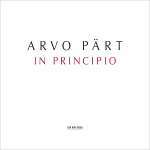|
Back
04/21/2009
Arvo Pärt: In Principio – La Sindone – Cecilia, vergine romana – Da pacem Domine – Mein Weg – Für Lennart in memoriam
Estonian Philharmonic Chamber Choir, Estonian National Orchestra, Tallinn Chamber Orchestra, Tõnu Kaljuste (conductor)
Recorded in the Estonian Concert Hall (June 2008 [In Principio, La Sindone, Cecilia, vergine romana]) & Niguliste Church, Tallinn (May 2007 [Da pacem Domine, Mein Weg, Für Lennart in memoriam]) – 70’21
ECM 2050 – Booklet in German and English

This is an important release for fans of Arvo Pärt. He possesses one of the most immediately recognizable compositional voices, especially since his adoption of the “tintinnabulation” technique in the 1970s, and the more recent works on this disc show a slight stylistic digression from his more well-known pieces. Pärt has passed through several style periods and one senses a true sense of organic development and progress in the more recent works on this collection.
The disc begins with an effective string and percussion reworking of his 1989 organ piece Mein Weg. The urgent rhythms underlying the slow overall harmonic progression convey a hypnotic urgency, and this work bears the most immediate similarity to Pärt’s most popular creations. Pärt’s control of tension is masterly and the emotional impact of the climax is undeniable. The percussion writing succeeds well in the arrangement, with the bass drum articulations adding a slow, steady heartbeat below the more quickly flowing string writing.
Two other purely instrumental compositions are included on the disc. La Sindone, from 2005, is a 15-minute orchestral work, the title referring to Jesus’ shroud. The introduction immediately presents more complex chords than one typically associates with Pärt, their descent leading to a hushed, long middle section. This central panel is a slowly unfolding series of overlapping motives in the strings occasionally overlaid by percussion and solo string figuration. It hearkens back to viol consort music, and Pärt structures an extremely controlled, gradual ascent and crescendo that culminates in a violent climax reminiscent of his early, brash 12-tone music. This is summarily dismissed by a final, hushed consonant chord in the strings. Für Lennart in memoriam, commissioned by former Estonian president Lennart Meri for his own burial service, is a gorgeous song-without-words for strings. The middle portion of the work, especially, is bittersweet and heart-wrenching in a Schubertian manner, the major mode evoking a deeper sense of loss and nostalgia than the surrounding minor mode material. Again, one marvels at the controlled architecture of the piece, which progresses with purpose and economy yet also engages emotionally. I wouldn’t be surprised if this became one of Pärt’s most performed compositions.
Three choral works fill out the disc. Da pacem Domine, composed for Jordi Savall, is the simplest on the disc, immediately communicating the plea for peace and striking a mournful tone. Existing in variable scorings, it is performed here with the orchestral doubling the choral parts. Cecilia, vergine romana emerges from silence and tells the life story of the patron saint of music. It bears striking similarities to Pärt’s Luke Passion and contains many ritualistic silences. The piece builds gradually in intensity to a shattering culmination at Cecilia’s martyrdom, after which Pärt conjures an eerie, relentless cortege of mournful chords in the chorus and strings disturbed by sharp, repeated figures in the other instruments. The ending is ingenious, an amber-hued “Amen” above a never-resolving ostinato figure that is abruptly cut off. The five-movement In Principio, on texts from the Gospel of John, contains the most striking contrasts in its nearly 20-minute duration. The first movement is a granitic alternation of static choral chords embellished by rocketing string arpeggios and a brass and timpani statement. The lengthy third movement, emphasizing the core of the entire text, is beautifully sustained with two-part choral figures alternating around a static string texture. Pärt frames the work with a fifth movement that reverses the two roles of the first movement, the chorus now set free harmonically, the interjections from the orchestra static. I find Cecilia the more convincing of the two extended vocal works, largely due to the more controlled and easily discernable structure.
The ECM engineers effectively capture the two contrasting recording venues. The Niguliste Church’s acoustics are extremely resonant and seem to highlight the lower sounds of the ensemble, and this casts a marvelous glow over the music, highly effective in Mein Weg. The location was smartly changed to the Estonia Concert Hall for the larger and more dynamically varied works, allowing the climaxes to have plenty of impact without creating a reverberant cloud of sound that would bury the quiet music that inevitably follows.
The strings of the Tallinn Chamber Orchestra are excellent in their tonal blend, balance and intonation, both in soloistic an ensemble passages. In Da pacem Domine, the doubling of the choral parts by the orchestra combined with the reverberant acoustics create moments of cloudiness that don’t work as well as they do in Mein Weg. It would have perhaps been more effective to have the former work performed a capella. The playing of the Estonian National Symphony Orchestra is likewise excellent. The occasional wind and brass solos have a distinctive Eastern-European timbre that adds an appropriate acerbic hue to the picture. Tõnu Kaljuste exhibits excellent control in all of the pieces, clearly understanding the architecture of the works and gracefully terracing climactic moments.
The booklet contains all Latin texts with German and English translations and informative program notes on each work by Wolfgang Sandner. Pärt is an important part of ECM’s catalogue, and the recording company pays him splendid dividend in this recording. All in all, it makes one eager to see where Pärt progresses next with his distinctive musical language.
Marcus Karl Maroney
|